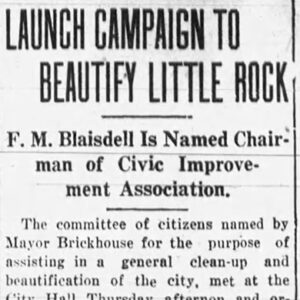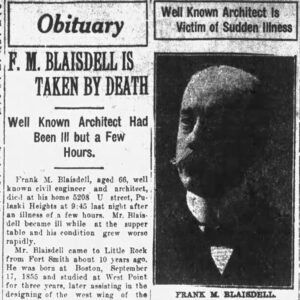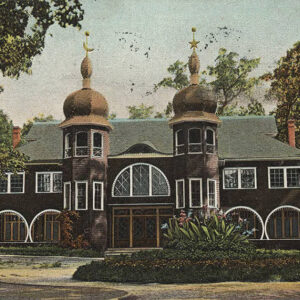calsfoundation@cals.org
Frank M. Blaisdell (1855–1921)
Frank M. Blaisdell was an architect and civil engineer who settled in Arkansas in 1905 and played a vital role in the growth of Little Rock (Pulaski County). While he was primarily a landscape architect, he left a permanent mark on the state by designing several buildings that still stand in the twenty-first century.
Frank M. Blaisdell was born on September 17, 1855, in Boston, Massachusetts, to Mary A. Blaisdell and William Blaisdell. His father, who held the rank of general, was killed in battle at Petersburg, Virginia, during the Civil War in 1864. After his father’s death, Blaisdell became involved with the Massachusetts Commandery of the Military Order of the Loyal Legion. He attended West Point for three years and served in the U.S. Army as an engineer. He received no formal training in architecture but gained early architectural experience assisting with the design of the west wing of the Army and Navy Club building in Washington DC.
While taking jobs around the country as a landscape architect, he married Isabelle Burr (Belle) Brace of Connecticut. They lived in Augusta, Georgia, where their daughter was born in 1884.
With the popularization of the electric streetcar throughout the United States starting in the 1890s, streetcar companies saw an opportunity to create their own destinations, often at the end of the line. These trolley parks were a precursor to modern amusement parks. Blaisdell made his early career as a landscape architect for a number of such parks, including Norumbega Park in his native Boston; Ravinia Park in Chicago, Illinois (which still hosts a popular music festival every year); and, in Arkansas, Electric Park in Fort Smith (Sebastian County), the site of what is now Kay Rodgers Park. Blaisdell worked on a number of similar parks on the East Coast, including Driving Park and Riverton Park in Portland, Maine; Merrymeeting Park in Brunswick, Maine; and Cascade Park in New Castle, Pennsylvania.
It is possible that the construction of Electric Park is what brought the Blaisdell family to Fort Smith from Augusta, Georgia, in 1905. Blaisdell stayed in Fort Smith and practiced for the next six years until he was called to Little Rock to landscape the new Arkansas State Capitol grounds in 1911. He took on a variety of jobs in Little Rock. Fay Hempstead wrote of him: “Early in the spring of 1911 he took up his permanent residence at Little Rock, and is devoting the greater part of his attention to landscape architecture, although he maintains at his offices departments under competent heads for general engineering, surveying and building architecture.” A 1917 Little Rock city directory lists him thusly: “Frank M. Blaisdell—Architect and Civil Engineer—to supply plans for public buildings, colleges, schools, churches, banks, theatres and artistic bungalows.”
Once settled in Little Rock, Blaisdell promptly became active in public life, serving as president of the Social Service League, the Civic Improvement Association, and the Arkansas Association of Surveyors and Civil Engineers, as well as running as a Republican for county and probate judge in 1914, though these campaigns were unsuccessful.
The high-profile work on the new capitol grounds led immediately to landscape work for Judge Carroll D. Wood’s house in the Hillcrest neighborhood, the construction of a bungalow for businessman A. C. Read, and the construction of a residence for W. C. Foster, which stands at 22nd and Gaines.
Blaisdell’s daughter, Frances Lillian (F. L.) Blaisdell, took an early interest in surveying work with her father. As soon as she completed high school, she started a map-making business, becoming the first published female cartographer in Arkansas, and she produced maps of the entire state that were considered to be the most authoritative of the time. She shared an office with her father at 917–918 Southern Trust Building (221 West 2nd St.) in Little Rock (now Pyramid Place).
In 1912, as Little Rock expanded westward, Blaisdell applied his landscaping skill to a project known as Young’s Park, in collaboration with Joseph E. England of England Land and Trust Company. Known today as Capitol View, it encompassed the blocks just south of the Arkansas School for the Blind, bounded to the north by Markham, Woodrow to the west, Thayer to the east, and Capitol to the south. Blaisdell’s unique, park-like approach to platting a residential area on a hillside made the area unique amidst the surrounding city grid when viewed from above.
In 1913, Blaisdell received a commission to design the Mosaic Templars building at 9th and Broadway. An annex to the building was built in 1918, and then another, the Mosaic State Templars Building, was constructed in 1921 according to plans by W. T. Bailey, an African-American architect. Blaisdell’s original building burned in 2005, but the campus was reconstructed as the Mosaic Templars Cultural Center.
In 1916, Little Rock College (now St. John Catholic Center at 2500 N. Tyler) opened in Forest Park, one of Little Rock’s emergent streetcar suburbs (which later became the area called the Heights). Blaisdell received the commission to design the campus layout, as well as three buildings (Fitzgerald, Byrne, and Morris halls) on campus, which were done in Collegiate Gothic or Gothic Revival style.
Blaisdell also designed the buildings for the agricultural schools at what are now Arkansas State University in Jonesboro (Craighead County) and Arkansas Tech University in Russellville (Pope County), as well as the administration building at Henderson-Brown College in Arkadelphia (Clark County), the last of which still stands on the campus of what is now Henderson State University. In May 1921, Blaisdell and Eugene Stern (of Mann & Stern) went to Washington DC as the two delegates from Arkansas to the American Institute of Architects fifty-fourth annual convention.
Blaisdell died on November 15, 1921, at the family home at 5208 U Street (now Country Club Boulevard) in Little Rock after a sudden illness. He is buried beside his wife and daughter in the Fort Smith National Cemetery.
For additional information:
“F. M. Blaisdell Is Taken by Death.” Arkansas Gazette, November 16, 1921, p. 18.
Hempstead, Fay. Historical Review of Arkansas: Its Commerce, Industry and Modern Affairs. Vol. 3. Chicago: Lewis Publishing Company, 1911. Online at https://archive.org/details/historicalreview03hemp (accessed March 23, 2018).
Smith, Sandra Taylor, and Anne Wagner Speed. “Little Rock’s Capitol View Neighborhood Historic District.” Little Rock: Arkansas Historic Preservation Program. Online at http://www.arkansaspreservation.com/News-and-Events/publications (accessed March 23, 2018).
Who’s Who in Little Rock, Nineteen Hundred and Twenty-One: An Accurate Biographical Record of Men and Women of Little Rock, Ark., Prominent in Various Lines of Civic Activity. Little Rock: Who’s Who Publishers, 1921. Online at https://archive.org/details/whoswhoinlittler00unse (accessed March 23, 2018).
Witsell, Charles, and Gordon Wittenberg. Architects of Little Rock: 1833–1950. Fayetteville: University of Arkansas Press, 2014.
Andrew McClain
Arkansas State Archives
 Early Twentieth Century, 1901 through 1940
Early Twentieth Century, 1901 through 1940 Science and Technology
Science and Technology Beautify Little Rock Committee
Beautify Little Rock Committee  Frank Blaisdell Obituary
Frank Blaisdell Obituary  Electric Park Pavilion
Electric Park Pavilion 




Comments
No comments on this entry yet.